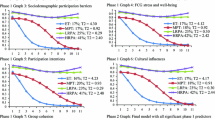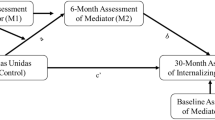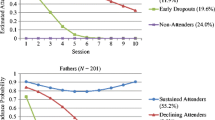Abstract
We examined attendance trajectory profiles among 335 Mexican-American families participating in an 11-week universal intervention to explore if heterogeneity in attendance and thus dosage was associated with intervention response, defined as pre-to-2-year post (T2) reductions in child report of internalizing symptoms. We estimated trajectories accounting for the influence of baseline covariates, selected based on the Health Belief Model (HBM) and Latino family research, to understand covariate associations with trajectories. Results supported six attendance trajectory groups: non-attenders (NA), early dropouts-low internalizing (EDO-LI), early dropouts-high internalizing (EDO-HI), mid-program dropouts (MPDO), sustained attenders-low internalizing (SA-LI), and sustained attenders-high internalizing (SA-HI). All groups except EDO-HI showed significant pre-to-post change on child report of internalizing; however, trajectory groups reflecting more attendance did not have greater pre-to-post change. Nonetheless, child report of internalizing differentiated two subgroups of sustained attenders and two subgroups of early dropouts. These results suggest heterogeneity among families with similar patterns of attendance and highlight the importance of modeling this heterogeneity. Although life stress was a barrier to participation, there was minimal support for the HBM. Cultural influences, acculturation, and familism, played a more prominent role in distinguishing trajectories. As expected, the EDO-HI group was less acculturated than both sustained attender groups and reported weaker familism values than the SA-HI group. However, unexpectedly, the SA-LI group had lower familism than the EDO-LI group. The results suggest that the influence of culture on participation is nuanced and may depend on child symptomatology.




Similar content being viewed by others
References
Achenbach, T. M. (1991). Child behavior checklist/4-18. Burlington: University of Vermont.
Asparouhov, T., & Muthén, B. (2012). Using Mplus TECH11 and TECH14 to test the number of latent classes.
Baker, C. N., Arnold, D. H., & Meagher, S. (2011). Enrollment and attendance in a parent training prevention program for conduct problems. Prevention Science, 12(2), 126–138.
Carpentier, F. R. D., Mauricio, A. M., Gonzales, N. A., Millsap, R. E., Meza, C. M., Dumka, L. E., German, M., & Genalo, M. T. (2007). Engaging Mexican origin families in a school-based preventive intervention. The Journal of Primary Prevention, 28, 521–546.
Coatsworth, J. D., Duncan, L. G., Pantin, H., & Szapocznik, J. (2006). Patterns of retention in a preventive intervention with ethnic minority families. Journal of Primary Prevention, 27, 171–193.
Cuellar, I., Arnold, B., & Maldonado, R. (1995). Acculturation rating scale for Mexican Americans-II: A revision of the original ARSMA scale. Hispanic Journal of Behavioral Sciences, 17, 275–304.
Dishion, T. J., & McMahon, R. J. (1998). Parental monitoring and the prevention of child and adolescent problem behavior: A conceptual and empirical formulation. Clinical Child and Family Psychology Review, 1(1), 61–75.
Dumka, L. E., Prost, J., & Barrera, M., Jr. (2002). The parental relationship and adolescent conduct problems in Mexican American and European American families. Journal of Couple & Relationship Therapy, 1, 37–57.
Enders, C. K., & Bandalos, D. L. (2001). The relative performance of full information maximum likelihood estimation for missing data in structural equation models. Structural Equation Modeling, 8, 430–457.
Gonzales, N., Dumka, L., Mauricio, A., & German, M. (2007). Building bridges: Strategies to promote academic and psychological resilience for adolescents of Mexican origin. In J. E. Lansford, K. Deater-Deckard, & M. H. Bornstein (Eds.), Immigrant families in contemporary society (pp. 268–286). New York: Guilford Press.
Gonzales, N. A., Dumka, L. E., Millsap, R. E., Gottschall, A., McClain, D. B., Wong, J. J., German, G., Mauricio, A. M., Wheeler, L., Carpentier, F. D., & Kim, S. Y. (2012). Randomized trial of a broad preventive intervention for Mexican American adolescents. Journal of Consulting and Clinical Psychology, 80, 1–16.
Gonzales, N. A., Wong, J. J., Toomey, R. B., Millsap, R., Dumka, L. E., & Mauricio, A. M. (2014). School engagement mediates long term prevention effects for Mexican American adolescents. Prevention Science, 15, 929–939.
Gorman-Smith, D., Tolan, P. H., Henry, D. B., Leventhal, A., Schoeny, M., Lutovsky, K., & Quintana, E. (2002). Predictors of participation in a family-focused preventive intervention for substance use. Psychology of Addictive Behaviors, 16(4S), S55.
Gottfried, A. E., Fleming, J. S., & Gottfried, A. W. (1994). Role of parental motivational practices in children’s academic intrinsic motivation and achievement. Journal of Educational Psychology, 86(1), 104.
Hill, N. E., & Torres, K. (2010). Negotiating the American dream: The paradox of aspirations and achievement among Latino students and engagement between their families and schools. Journal of Social Issues, 66(1), 95–112.
Janz, N. K., & Becker, M. H. (1984). The health belief model: A decade later. Health Education & Behavior, 11, 1–47.
Kazdin, A. E., & Mazurick, J. L. (1994). Dropping out of child psychotherapy: Distinguishing early and late dropouts over the course of treatment. Journal of Consulting and Clinical Psychology, 62(5), 1069.
Kazdin, A. E., Holland, L., Crowley, M., & Breton, S. (1997). Barriers to treatment participation scale: Evaluation and validation in the context of child outpatient treatment. Journal of Child Psychology and Psychiatry, 38, 1051–1062.
Knight, G. P., Gonzales, N. A., Saenz, D. S., Bonds, D. D., Germán, M., Deardorff, J., Roosa, M. W., & Updegraff, K. A. (2010). The Mexican American cultural values scale for adolescents and adults. The Journal of Early Adolescence, 30, 444–481.
Kumpfer, K. L., Alvarado, R., Smith, P., & Bellamy, N. (2002). Cultural sensitivity and adaptation in family-based prevention interventions. Prevention Science, 3(3), 241–246.
Lo, Y., Mendell, N. R., & Rubin, D. B. (2001). Testing the number of components in a normal mixture. Biometrika, 88, 767–778.
McKay, M. M., & Bannon, W. M., Jr. (2004). Engaging families in child mental health services. Child and Adolescent Psychiatric Clinics of North America, 13(4), 905–921.
McKay, M. M., Hibbert, R., Hoagwood, K., Rodriguez, J., Murray, L., Legerski, J., & Fernandez, D. (2004). Integrating evidence-based engagement interventions into “real world” child mental health settings. Brief Treatment and Crisis Intervention, 4(2), 177.
Merikangas, K. R., He, J. P., Burstein, M., Swanson, S. A., Avenevoli, S., Cui, L., & Swendsen, J. (2010). Lifetime prevalence of mental disorders in US adolescents: Results from the National Comorbidity Survey Replication–Adolescent Supplement (NCS-A). Journal of the American Academy of Child & Adolescent Psychiatry, 49, 980–989.
Muthén, B. O. (2002). Beyond SEM: General latent variable modeling. Behaviormetrika, 29(1; ISSU 51), 81–118.
Muthén, B. (2004). Latent variable analysis: Growth mixture modeling and related techniques for longitudinal data. In D. Kaplan (Ed.), Handbook of quantitative methodology for the social sciences (pp. 345–368). Newbury Park: Sage.
Muthén, L. K., & Muthén, B. O. (1998–2013). Mplus user’s guide. 7th ed. Los Angeles: CA: Muthén and Muthén.
NRC/IOM. (2009). Preventing mental, emotional, and behavioral disorders among young people: Progress and possibilities. Washington, DC: The National Academy Press.
Perrino, T., Coatsworth, J. D., Briones, E., Pantin, H., & Szapocznik, J. (2001). Initial engagement in parent-centered preventive interventions: A family systems perspective. Journal of Primary Prevention, 22, 21–44.
Pew Hispanic Center. (2006). Pew Hispanic Center Fact Sheet: Statistical portrait of Hispanics in the United States 2006. Los Angeles: University of Southern California Annenberg School for Communication. http://pewhispanic.org/files/other/middecade/Table 3.pdf
Radloff, L. S. (1977). The CES-D scale a self-report depression scale for research in the general population. Applied Psychological Measurement, 1, 385–401.
Reid, M. J., Webster-Stratton, C., & Baydar, N. (2004). Halting the development of conduct problems in head start children: The effects of parent training. Journal of Clinical Child and Adolescent Psychology, 33(2), 279–291.
Reyno, S. M., & McGrath, P. J. (2006). Predictors of parent training efficacy for child externalizing behavior problems—a meta‐analytic review. Journal of Child Psychology and Psychiatry, 47, 99–111.
Rosenstock, I. M., Strecher, V. J., & Becker, M. H. (1988). Social learning theory and the health belief model. Health Education & Behavior, 15(2), 175–183.
Schaeffer, C. M., Petras, H., Ialongo, N., Masyn, K. E., Hubbard, S., Poduska, J., & Kellam, S. (2006). A comparison of girls’ and boys’ aggressive-disruptive behavior trajectories across elementary school: prediction to young adult antisocial outcomes. Journal of Consulting and Clinical Psychology, 74(3), 500.
Sclove, S. L. (1987). Application of model-selection criteria to some problems in multivariate analysis. Psychometrika, 52, 333–343.
Small, S. A., & Kerns, D. (1993). Unwanted sexual activity among peers during early and middle adolescence: Incidence and risk factors. Journal of Marriage and the Family, 55, 941–952.
Spoth, R., & Redmond, C. (1995). Parent motivation to enroll in parenting skills programs: A model of family context and health belief predictors. Journal of Family Psychology, 9, 294–310.
Szapocznik, J., & Coatsworth, J. D. (1999). An ecodevelopmental framework for organizing the influences on drug abuse: A developmental model of risk and protection. In M.D. Glantz, & C.R. Hartel (Eds.), Drug abuse: Origins & interventions (pp. 331-366). Washington, DC: American Psychological Association.
U.S. Department of Education. (2000). Dropout rates in the United States: 1998. (NCES 2000–022). Washington DC: U.S. Government Printing Office.
Wang, P. S., Simon, G., & Kessler, R. C. (2003). The economic burden of depression and the cost‐effectiveness of treatment. International Journal of Methods in Psychiatric Research, 12(1), 22–33.
Acknowledgments
This study was supported by the National Institute of Mental Health grant MH064707.
Author information
Authors and Affiliations
Corresponding author
Ethics declarations
Funding
Development and evaluation of the Bridges to High School program (Bridges), including the data collected and used in this study, were supported by the National Institute of Mental Health grant MH64707.
Conflict of Interest
Drs. Gonzales and Dumka are the developers of the Bridges program; Dr. Mauricio was involved in implementation of the Bridges program during its efficacy trial; Drs. Tein and Millsap were involved in the evaluation of the efficacy of the Bridges program. The authors declare that they have no other conflicts of interest.
Ethical Approval
All study procedures and measures were reviewed and approved by the Arizona State University Institutional Review Board. All procedures performed in studies involving human participants were in accordance with the ethical standards of the institutional and/or national research committee and with the 1964 Helsinki declaration and its later amendments or comparable ethical standards.
Informed Consent
Informed consent was obtained from all participants in this study and assent was obtained from minors included in the study.
Additional information
The authors dedicate this paper to the memory of Roger E. Millsap in gratitude for his mentorship and support and for his significant contributions to this project and prevention science.
Electronic Supplementary Material
Below is the link to the electronic supplementary material.
ESM 1
(DOC 209 kb)
Rights and permissions
About this article
Cite this article
Mauricio, A.M., Tein, JY., Gonzales, N.A. et al. Attendance Patterns and Links to Non-Response on Child Report of Internalizing among Mexican-Americans Randomized to a Universal Preventive Intervention. Prev Sci 19 (Suppl 1), 27–37 (2018). https://doi.org/10.1007/s11121-016-0632-9
Published:
Issue Date:
DOI: https://doi.org/10.1007/s11121-016-0632-9




